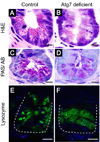A common role for Atg16L1, Atg5 and Atg7 in small intestinal Paneth cells and Crohn disease
- PMID: 19139628
- PMCID: PMC2940227
- DOI: 10.4161/auto.5.2.7560
A common role for Atg16L1, Atg5 and Atg7 in small intestinal Paneth cells and Crohn disease
Abstract
Recently identified genetic determinants for enhanced susceptibility to Crohn disease (CD) included polymorphisms in the ATG16L1 and IRGM1 loci suggesting that the autophagy pathway plays a role in the pathogenesis of this disease. We have generated and analyzed three mouse models with diminished expression of autophagy proteins and show how the loss of function of various autophagy components contributes to CD pathogenesis. In the mouse small intestine, one common cellular target of Atg16L1, Atg5 and Atg7 is the Paneth cell, a specialized epithelial cell whose main function is the delivery of antimicrobial factors into the intestinal lumen by production and secretion of its characteristic cytoplasmic granules. Autophagy-deficient Paneth cells exhibited a striking loss of function in this granule exocytosis pathway. Transcriptional analysis revealed a gain of function whereby the gene expression associated with inflammatory responses was increased in autophagy-deficient Paneth cells. Importantly, we validated these findings by analyzing intestinal tissues from CD patients. Similar Paneth cell abnormalities were observed in CD patients homozygous for the ATG16L1 risk allele. Thus, one role for the autophagy pathway in CD pathogenesis is through selective effects on the biology and specialized properties of Paneth cells.
Figures

References
-
- Barrett JC, Hansoul S, Nicolae DL, Cho JH, Duerr RH, Rioux JD, Brant SR, Silverberg MS, Taylor KD, Barmada MM, Bitton A, Dassopoulos T, Datta LW, Green T, Griffiths AM, Kistner EO, Murtha MT, Regueiro MD, Rotter JI, Schumm LP, Steinhart AH, Targan SR, Xavier RJ, Libioulle C, Sandor C, Lathrop M, Belaiche J, Dewit O, Gut I, Heath S, Laukens D, Mni M, Rutgeerts P, Van GA, Zelenika D, Franchimont D, Hugot JP, de VM, Vermeire S, Louis E, Cardon LR, Anderson CA, Drummond H, Nimmo E, Ahmad T, Prescott NJ, Onnie CM, Fisher SA, Marchini J, Ghori J, Bumpstead S, Gwilliam R, Tremelling M, Deloukas P, Mansfield J, Jewell D, Satsangi J, Mathew CG, Parkes M, Georges M, Daly MJ. Genome-wide association defines more than 30 distinct susceptibility loci for Crohn's disease. Nat. Genet. 2008;40:955–962. - PMC - PubMed
-
- Xavier RJ, Podolsky DK. Unravelling the pathogenesis of inflammatory bowel disease. Nature. 2007;448:427–434. - PubMed
-
- Rioux JD, Xavier RJ, Taylor KD, Silverberg MS, Goyette P, Huett A, Green T, Kuballa P, Barmada MM, Datta LW, Shugart YY, Griffiths AM, Targan SR, Ippoliti AF, Bernard EJ, Mei L, Nicolae DL, Regueiro M, Schumm LP, Steinhart AH, Rotter JI, Duerr RH, Cho JH, Daly MJ, Brant SR. Genome-wide association study identifies new susceptibility loci for Crohn disease and implicates autophagy in disease pathogenesis. Nat. Genet. 2007;39:596–604. - PMC - PubMed
-
- Hampe J, Franke A, Rosenstiel P, Till A, Teuber M, Huse K, Albrecht M, Mayr G, De LV, Briggs J, Gunther S, Prescott NJ, Onnie CM, Hasler R, Sipos B, Folsch UR, Lengauer T, Platzer M, Mathew CG, Krawczak M, Schreiber S. A genome-wide association scan of nonsynonymous SNPs identifies a susceptibility variant for Crohn disease in ATG16L1. Nat. Genet. 2007;39:207–211. - PubMed
Publication types
MeSH terms
Substances
Grants and funding
LinkOut - more resources
Full Text Sources
Other Literature Sources
Medical
Molecular Biology Databases
